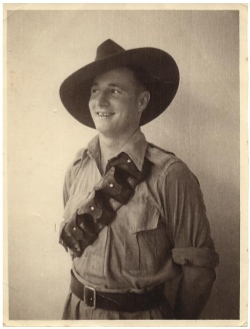 |
 |
![]()
| Remembrance Day Address 2008 |
| by Norman Anderton MBE NX57502 - 8th Division Signals |
I feel greatly honoured to have been invited to give this address today.
What better day than today, Remembrance Day,
to remember some real heroes, I refer of course to the Doctors who were
on the Burma Thailand Railway. These men, who to paraphrase
Winston Churchill "did so much to help so many when they were so few."
There were 43 Australian doctors, even more British doctors, numerous
Dutch, two Americans and a Canadian on the Burma Thailand
Railway. I could not mention them all. I must acknowledge
that present here today there are five members of the family of British
doctor Major Vincent Bennett and the step-daughter and son-in-law of
Australian doctor Captain John Lindsey Taylor MC.
I would like to mention 5 doctors with whom I had some personal
involvement. First and foremost was Dr Roy Mills, the Medical
Officer with Pond's Party, part of the larger "F" Force at Taimonta and
Konkoita. Roy was a gentle, mild mannered soul who was unlucky
enough to come under the control of one of the most brutal Japanese
Camp Commanders on the line, Capt. Muryama, a big brutal, sadistic ex
Military Policeman who was later tried as a War Criminal and was.
sentenced to death. The sentence was later commuted.
Captain Mills suffered many bashings at the hands of Muryama and his
henchmen in trying to save sick men being forced out to work. As
a large number of my Unit, 8th Division Signals, were with Pond's Party
he was later made an Honorary member of our Unit Association.
When I went down with dysentery I was transferred to Nikke Camp where I
met Dr Peter Hendry. In his own words Peter said he tried to
accommodate the Japs demands for "workers", as the men would have been
forced out to work regardless. So he had the unenviable task of
selecting the fittest of the sick to fill the work quotas.
While at Nikki I was also infected with Malaria and as the line was
completed down as far as Nikki from the Burma end I was, along with
many others, sent by train to the Tan Baya Sick Camp in Burma.
About 1,900 "F" force men were sent to Tan Baya around August 1943 and
by year's end 671 had died.
At Tan Baya Hospital Camp I met Doctors Major Bruce Hunt, Captain Frank
Cahill and an Indian Medical Service doctor, Dr Patrick
Wolfe. Bruce Hunt, who was in charge, was a strict disciplinarian
and on our return to Singapore suffered some criticism for his
methods. But he brought "order out of chaos" and did a
magnificent job controlling that Camp.
Having recovered from dysentery and malaria I offered my services as a
voluntary medical orderly and was "put to work" in the combined
Ulcer/Dysentery Ward. Not the most salubrious of places in which
to work.
On some mornings I would have to accompany Dr Wolfe, a small but very
happy man, to conduct a "dawn patrol" to see how many patients had died
during the night and arrange for the bodies to be taken to the
cremation area. As was traditional at that time all the British
and Australian doctors were accorded the rank of at least Captain but
Dr Wolfe of the Indian Army Medical Service, despite being a fully
qualified doctor, was only accorded the rank of Sergeant Major.
If my memory serves me right, there were some 40 amputations performed
at Tan Baya and Dr Frank Cahill, being the only surgeon there, did them
all. Working with only the most basic items of equipment, some
scalpels, some forceps and a wood saw that was also used for cutting
wood for the kitchen and the funeral pyre and then had to be sterilized
in boiling water before being used to saw through the bones. On
one or two occasions I was present with an empty rice sack to collect
the amputated limb and take it to the cremation area.
Unfortunately only four amputees survived as most were too debilitated
to withstand the shock of the operation
These courageous and dedicated doctors will always hold a place of
honour in the memory of all those to whom they ministered during those
dark days. It is fortunate that Don Wall published his book
"Heroes of "F" Force". In conclusion, we should acknowledge the
efforts of all the doctors and the others who helped their mates.
They are all truly "unsung heroes".
Lest we forget.

|
|